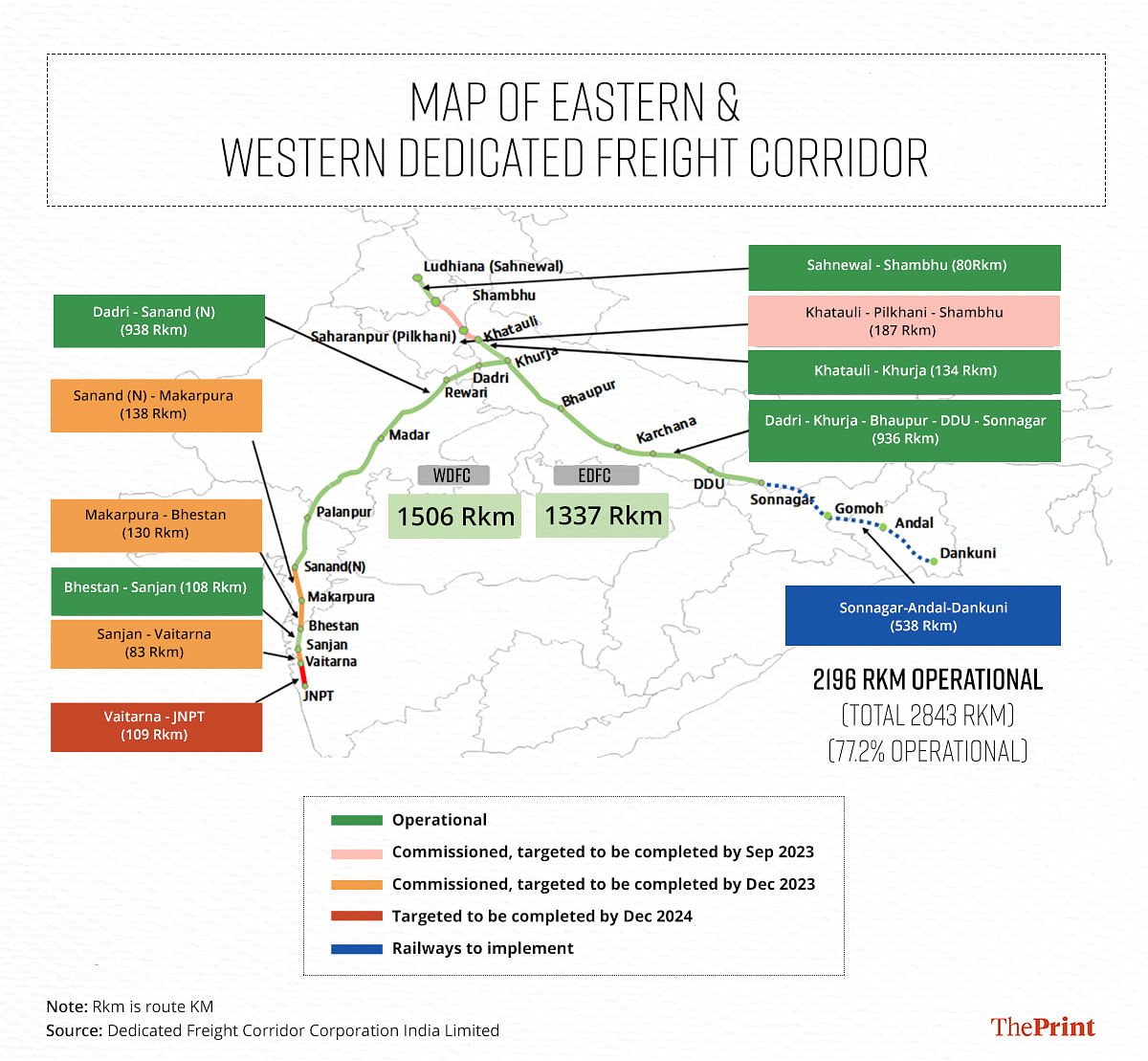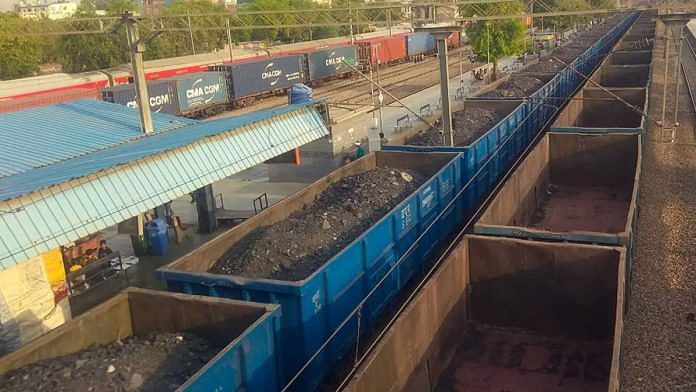New Delhi: As many as 154 trains — carrying bulk cargo, including coal, steel, cement and foodgrains — criss-crossed the newly-commissioned sections of the eastern segment of the Dedicated Freight Corridor (DFC) on a single day last week, setting a milestone of sorts for the Rs 1.24 lakh crore project that was approved in 2006.
The DFC is one of the largest rail projects executed by the Indian Railways to date.
On an average day, around 140 trains carrying coal and steel ply the Eastern Dedicated Freight Corridor (EDFC) — one-half of the DFC that provides seamless freight transportation between eastern, northern and western India. The DFC’s other arm is the Western Dedicated Freight Corridor (WDFC).
The DFC is finally inching towards completion, 17 years after the Union Cabinet approved the project along the eastern and western arms of the Golden Quadrilateral, the national highway network connecting Delhi, Kolkata, Mumbai and Chennai.
Almost 80 percent of the 2,843-km DFC had become operational by August this year, according to the Dedicated Freight Corridor Corporation of India Limited (DFCCIL), a subsidiary of the Indian Railways and a special purpose vehicle set up to implement the project.
Work on the last 187-km stretch of the 1,337-km EDFC, connecting Sahnewal in Punjab to Sonnagar in Bihar, is scheduled be completed this month, say DFCCIL officials, with train operations on the stretch starting in October. The WDFC connecting Dadri in Uttar Pradesh to Jawaharlal Nehru Port Trust (JNPT) in Maharashtra is also close to completion, although running a little behind the EDFC timeline, they add.
The longest stretch on the WDFC — 938 km between Dadri and Sanand in Gujarat — became operational last month, resulting in seamless freight transportation from the hinterland of UP to the western ports of India.
Barring a 109-km stretch between Vaitarna (river in Maharashtra) and JNPT, the remaining 1,506-km section of the western corridor is targeted for completion this fiscal year.
“The Vaitarna-JNPT stretch is targeted for completion by December 2024. There are land-acquisition issues there. Also, because of rains, we get fewer working seasons,” DFCCIL managing director R.K. Jain told ThePrint.
Originally, the eastern corridor was to start from Ludhiana and culminate in Dankuni in West Bengal. But the 538-km stretch between Sonnagar and Dankuni is not being executed by the DFCCIL anymore. The railway ministry will execute it on its own.
A senior railway ministry official said that the railways initially wanted to develop the stretch in a public-private partnership (PPP) mode. But it failed to get bidders for the stretch twice.
“Now, it will be constructed in two phases. The first phase between Sonnagar and Andal (town in Bengal) was sanctioned last month,” the official said.
One of the largest projects undertaken by the Indian Railways, the DFC covers nine states, spans 77 districts and involves approximately 11,000 hectares of land acquisition.
Currently, both passenger and freight trains move on the same rail tracks, leading to congestion on the route as well as holding up of freight trains, which results in a slowdown. Passenger trains are given priority over freight trains. A dedicated corridor for freight trains will ensure seamless and faster service, reducing the turnaround time.
The DFC project was a technological challenge too, and saw the construction of 304 road overbridges to bypass level crossings, and 560 road under-bridges.
At 53 locations, rail flyovers — where a passenger train will run on the ground and a freight train on the DFC will run over a bridge — are in various states of construction.
Also Read: India should aim to bring logistics cost to single-digit at earliest: PM Modi
‘Reliability of operations’
Jain calls the DFC a “game-changer” for India, where currently 26 percent of more than 1,500 million tonnes (MT) of freight annually is reported to move on rail.
A network of quality highways has ensured that the bulk of the freight transportation has moved to the roads over the years, in stark contrast to the 1950s, when most of the freight (85 percent) used to be carried by the Indian Railways.
“The Indian economy has grown so much but our share has reduced,” Jain said.
One reason for this was the slow speed of freight trains.
According to the records of the Indian Railways, as of now, freight trains from Mumbai take three days to reach Delhi.
Once all sections of the DFC are complete, this time will be reduced to 48 hours and there will be continuous flow of freight trains. They won’t have to wait for the tracks to clear, unlike now.
Currently, in eight hours, a driver is able to run a train for 200 km on average. That’s why it takes three days to reach Delhi from Mumbai, railway officials said.
The average speed of freight trains is 20 to 25 km per hour as of now, according to Indian Railways figures. On the DFC, however, the average speed will increase to over 60 km per hour, the figures estimate.
“There will be reliability of operations. The indirect advantage is that when all freight shifts to the DFC, movement of passenger trains will also become faster,” Jain said.
According to DFCCIL officials, the real benefit will start reflecting once the entire corridor is completed.

The EDFC, for instance, covers most of the coal and steel belts of eastern India. Coal from the eastern Indian coalfields of Bihar, Jharkhand and West Bengal is now being transported through the EDFC to power plants in UP, Punjab and Haryana.
Giving an example of how the DFC is helping save cost and time, a senior DFCCIL official told ThePrint that a power plant in Punjab used to keep a 30-day stock of coal.
“(But) now that the eastern corridor has become operational, the owner has reduced the stock to half (15 days) and says he is planning to reduce it to seven days. He has reduced approximately Rs 300-400 crore on inventory,” the official said.
According to Ashutosh Bhandari, senior practice leader (consulting), CRISIL Market Intelligence and Analytics, rail transportation has always been cheaper compared to road transportation.
“However, it faces challenges relating to the track’s load-bearing capacity, height restrictions, and congestion,” he said.
Bhandari added: “The DFC gives an exclusive corridor to freight movement, addressing all these challenges — thus reducing turn-around time, cost of transportation, as well as inventory-carrying requirements. These factors, in turn, will give sufficient incentives for increase in the modal share of railways in freight transportation, thus reducing carbon emissions as well as average cost of cargo movement.”
The existing share of freight traffic by rail is around 28 percent which, Bhandari said, should ideally increase to 40-45 percent because of the DFC.
“Currently in India, logistics cost is around 14 percent of total GDP, while the international standard is around 8 percent. The DFC will help bridge this gap by helping transport more cargo in one movement and asset sweating through reduced turnaround time,” he added.
Plenty of challenges
When the DFC was conceptualised in 2006, the project cost was Rs 28,000 crore. But the long gestation period saw the cost go up to Rs 1.24 lakh crore.
Funded jointly by the central government, World Bank and Japan International Cooperation Agency (JICA), the project, DFCCIL officials say, was not an easy one to implement.
Land acquisition was one of the biggest hurdles. Approximately 11,000 hectares of land in nine states spanning 77 districts was acquired. The process took close to four years, and is even now incomplete.
“Roughly, we spent Rs 21,000 crore on acquiring land. We dealt with approximately 3 lakh project-affected people and gave them compensation,” a second DFCCIL official told ThePrint.
Another challenge was shifting of utilities. “We spent Rs 10,000 crore to Rs 15,000 crore on shifting utilities, be it power transmission lines, the telecom network, gas pipelines, water supply and sewer lines, etc,” the official added.
Contract management and obtaining of regulatory clearances were other challenges. “Getting a no-objection certificate takes a minimum of one year. From the irrigation department to the environment department, there was hardly any department where we did not go,” the official said.
Even as the DFCCIL was resolving all these issues one step at a time, Covid struck in 2020. “We lost two working seasons,” the official said.
During the pandemic, contractors’ cashflow got disturbed because of which they had to pay labour despite no work taking place.
“In some places, their cash got stuck… because of all these reasons, they faced a lot of financial burden. Besides, the supply chain management got affected. There was no cement and steel in some places, while in some places we did not have oxygen for welding [oxygen was in short supply during parts of the pandemic because of its medical requirements]. This adversely affected work at all sites,” the official added.
According to Jain, it is a misconception that the DFC is a delayed project.
“The Cabinet approved the project in 2006, but till 2010, the project alignment kept changing. We finalised the alignment by 2011, after which we started acquiring land. It took a long time,” he said.
In 2013, the Land Acquisition Act was changed. “There was a one-year period when our entire land acquisition process was put on hold. No one was allowing us to acquire, saying that, under the new Act, they would get more compensation. Those whose land we had acquired already, they also started agitating,” said Jain.
“We started our work amid all these challenges and our intention was very clear — that we want to complete the project by 2022. But then, Covid struck,” he added.
‘Tariff is an issue’
Manish Puri, an independent consultant and president of Association of Container Train Operators, told ThePrint that the DFC can bring about a paradigm shift in the logistics sector, since the Indian Railways so far did not have adequate capacity to carry the freight it should ideally carry.
“Now that the capacity is there, the railways will have to ensure that the freight shifts to the DFC. If service is good, cargo will shift. For instance, on the WDFC, once trains started running, transit time from NCR to Gujarat was reduced by more than half. Cargo is now reaching in two days, as opposed to four-five days earlier, and this is often even better than on the road,” he said.
“The improvement in the transit side has benefitted from both the EDFC and WDFC. As a result, we are seeing a shift from road to rail,” he added.
But freight tariff is an issue. Puri pointed out that although, traditionally, the railways’ rate per-tonne km has been cheaper, rail is not an end-to-end service like road.
“For instance, in containers and other similar cargo, where penetration of the railways is five percent, current per-tonne cost of cargo on road, end to end, is cheaper than on the railways,” he said.
The DFC should have a multi-operator regime, Puri suggested.
“Right now, no private operators run trains on the DFC. It’s a single-operator regime. In theory, you have agreed to a multi-operator regime but you have to practise it too to make the project self-sustaining,” he added.
According to Jain, however, the DFCCIL, being a subsidiary of the Indian Railways, does not decide tariff and issues like allowing multiple operators.
“Freight tariff is determined by the Railway Board and is the same for all. The tariff is not high if you compare it with the seamless and reliable service,” he said.
(Edited by Nida Fatima Siddiqui)
Also Read: How Indian Railways’ anti-collision ‘Kavach’ works & why it may not have averted Odisha tragedy



